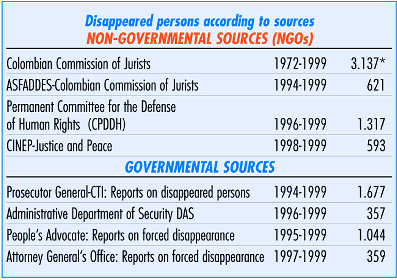

![]()
One way of approaching this problem
is to use information provided by NGOs, whose files on disappeared persons
are based on a traditional definition that restricts cases to those in
which agents of the state are held directly or indirectly responsible.
Following this criterion, 3,137 Colombians have disappeared in the past
29 years, according to the records of the Colombian Commission of Jurists
(CCJ), the largest sequence available. The Permanent Committee for the
Defense of Human Rights (CPDDH) keeps records of 1,319 persons disappeared
in the past four years. Cinep-Justice and Peace Databank, which has recorded
cases of disappearance of persons on a non-continuous basis since 1996
and uses non-exclusive categories, puts the figure at 593 cases in the
past two years.

Processed by: Observatory
on Human Rights, Office of the Vice President of Colombia.
|
Official bodies use other types of figures. Reports filed with both the Office of the People’s Advocate and the Attorney General’s Office relate to forced disappearance in its traditional definition, restricted to direct or indirect agents of the state. Official records of persons reported missing, kept by state bodies such as the Prosecutor General’s Office and the Administrative Department of Security, constitute another indicator of the problem that departs from the traditional views on forced disappearance. They are based on requests for the search of persons reported missing, filed by relatives with the various state bodies. The Technical Investigations Unit of the Prosecutor General’s Office (CTI) recorded 1,677 disappeared persons between 1994 and 1999. The DAS, for its part, recorded 465 between 1995 and June 2000.
An additional indicator of state
origin is based on the identification of nameless bodies. The CTI received
reports of 4,210 unidentified bodies between 1995 and 1999. The Center
for Criminality of the CTI informs of cases of disappearance of persons
that are resolved and those yet to be resolved at the Bogotá regional
office, and of those which are referred to the Center because of the impossibility
to resolve them locally. Therefore, the magnitude of the phenomenon of
unidentified bodies reported every year at a national level is greater
than the figures presented here would suggest. According to figures of
the Colombian Institute of Forensic Medicine and Forensic Science, 30 per
cent of the 5,453 bodies found between 1995 and 1999 were identified, while
3,832 corpses remained in the category of nameless bodies in the same period.
These figures include victims of social violence, persons who died of causes
other than violence, such as accidents, and persons who died of natural
causes when no relatives are found; not just individuals who disappeared
as a result of the political violence.
 |
Source:
Permanent Committee for the Defense of Human Rights
According to the Permanent Committee for the Defense of Human Rights, (CPDDH), between 1996 and 1999, 72 per cent of disappearances of persons occurred in eight departments: Antioquia, Cesar, Magdalena, Bolívar, Santander, Norte de Santander, Chocó and Córdoba. The trends are confirmed by an analysis of CINEP-Justice and Peace’s information. |
As far as the persons responsible
for forced disappearances are concerned, an analysis based on statistics
of non-governmental organizations, including the Colombian Commission of
Jurists, the Permanent Committee for the Defense of Human Rights, and CINEP-Justice
and Peace, allows us to establish that self-defense groups are the most
frequent offenders, followed by agents of the state. Reports of forced
disappearances filed with the Office of the People’s Advocate implicate
members of self-defense groups, and to a much lesser extent, members of
the Army and the National Police. Except for those compiled by the DAS,
no statistics are available that show the involvement of the guerrillas
in forced disappearances. This is due to the prevailing ideas concerning
forced disappearance, and to the definition of it in terms of the responsibility
of the state. According to the DAS, responsibility for forced disappearances
falls principally on common criminals, and secondly on the guerrillas.
The guerrillas are blamed for 35 per cent of cases between 1995 and 1999,
mostly of disappeared persons who are members of the police, and some members
of the military forces. Statistics for forced disappearance will widen
their scope in the future, in keeping with contemporary realities and with
the criteria established by the law recently approved, which includes illegal
groups.

• Records of the disappearance of persons began in 1972. The magnitude of this phenomenon remained low in Colombia during the 1970s. It increased substantially in the second half of Julio César Turbay’s term of office, and continued to rise -with fluctuations- until 1990. It then dropped back. In 1995 a new upwards trend began. Account should be taken of the fact that records refer to particular periods, and that they may be adjusted when disappeared persons are found to have actually been kidnapped, killed, and so on. • Historically, the disappeared persons curve, based on NGOs data, follows the same path as political killings and massacres, as an analysis made by the Observatory on Human Rights has shown. |
Regarding the areas where disappearances
take place, according to Permanent Committee for the Defense of Human Rights
data for 1996-1999, and CINEP-Justice and Peace data for 1998-1999, the
regions of Colombia where this phenomenon is most frequent are in the North.
As the Observatory on Human Rights notes, these regions correspond to zones
where fighting between self-defense groups and the guerrillas has been
most intense. From an analysis of CINEP-Justice and Peace records it can
be concluded that the majority of forced disappearances are related to
political persecution, and not so much to abuse of authority.